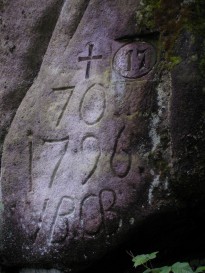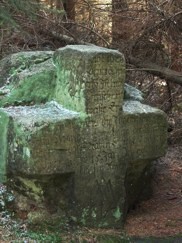Góry Stołowe - kraina zrodzona z morza
 Tourism
Tourism
The monuments of the region
 Undoubtedly, located on a steep wooded cone of Gomoła not far from the Polish Gate pass, the 13th century Homole castle ruins are the oldest monument in the region of the Stołowe Mountains and Lewin Hills,. We can notice the elements of late gothic in architecture of churches in Radków and Lewin Kłodzki. More numerous are monuments from the époques of renaissance and mannerism. The most valuable one is paper mill in Duszniki from 1605, representing industrial architecture - the only object of this type in Middle Europe. Inside the mill, there is a papermaking museum, in which demonstration of hand-made paper production is shown. An example of palace renaissance is a castle in Ratno Dolne, unfortunately in ruin. In the region of the Stołowe Mountains, the most popular architecture and art of baroque in the Sudety is represented by Wambierzyce, an interesting urban-sacred place, called "the Silesian Jerusalem", the ancient place of Virgin Mary cult. This complex was built in the second half of the 17th century and at the beginning of the 18th century. Apart from the town centre built after the example of the saint city of Jerusalem, it contains more than 70 Calvary chapels and a magnificent pilgrim church (class 1 monument). Baroque style to much less extent is represented by churches in Szczytna, Brzozów and Pasterka, as well as chapels in Town's Wood near Lewin Klodzki and the Saint Anna chapel near Batorów. Also in this style, the famous Skulls Chapel in Kudowa Czermna was built in 1776. The art of baroque and classicism was also reflected in the development of such towns as Radków or Lewin, and reconstruction of many earlier buildings, for example the residence of Count Mutius in Jeleniów, or also in equipping some of the churches in valuable sculptures and paintings - e.g. a whale-shaped pulpit and painting of the main altar in the Saint Peter's and Paul's Church in Duszniki. Among the youngest monuments of brick-architecture, there is a beautiful railway viaduct over the Bystra valley in the vicinity of Lewin Kłodzki, built at the beginning of the 20th century. Many valuable examples of folk architecture are found in villages in regions of the Stołowe Mountains and the Lewin Hills. Wooden, wooden-brick and brick huts represent typical features of Silesian-Czech village architecture. Some of them are being dismantled and brought to the territory of the Heritage Park of the Sudety architecture, which is now being created in Pstrążna not far from Kudowa. Numerous chapels and wayside crosses are also monuments of folk culture. Wooden signal belfries typical for Czech-Polish borderland are unique throughout the country. We can see them in upper Kudowa, Dańczów and the Heritage Park in Pstrążna. Of similar value are two movable Christ Child's cribs - the works of folk artists - located in Pstrążna and Wambierzyce. Examples of very valuable historic structures are penance crosses that appeared in Poland only in the region of Silesia, being the monuments of medieval law, put up to commemorate old crimes and tragedies. According to those law regulations binding in Silesia in the years 1301-1500, the court's sentence
Undoubtedly, located on a steep wooded cone of Gomoła not far from the Polish Gate pass, the 13th century Homole castle ruins are the oldest monument in the region of the Stołowe Mountains and Lewin Hills,. We can notice the elements of late gothic in architecture of churches in Radków and Lewin Kłodzki. More numerous are monuments from the époques of renaissance and mannerism. The most valuable one is paper mill in Duszniki from 1605, representing industrial architecture - the only object of this type in Middle Europe. Inside the mill, there is a papermaking museum, in which demonstration of hand-made paper production is shown. An example of palace renaissance is a castle in Ratno Dolne, unfortunately in ruin. In the region of the Stołowe Mountains, the most popular architecture and art of baroque in the Sudety is represented by Wambierzyce, an interesting urban-sacred place, called "the Silesian Jerusalem", the ancient place of Virgin Mary cult. This complex was built in the second half of the 17th century and at the beginning of the 18th century. Apart from the town centre built after the example of the saint city of Jerusalem, it contains more than 70 Calvary chapels and a magnificent pilgrim church (class 1 monument). Baroque style to much less extent is represented by churches in Szczytna, Brzozów and Pasterka, as well as chapels in Town's Wood near Lewin Klodzki and the Saint Anna chapel near Batorów. Also in this style, the famous Skulls Chapel in Kudowa Czermna was built in 1776. The art of baroque and classicism was also reflected in the development of such towns as Radków or Lewin, and reconstruction of many earlier buildings, for example the residence of Count Mutius in Jeleniów, or also in equipping some of the churches in valuable sculptures and paintings - e.g. a whale-shaped pulpit and painting of the main altar in the Saint Peter's and Paul's Church in Duszniki. Among the youngest monuments of brick-architecture, there is a beautiful railway viaduct over the Bystra valley in the vicinity of Lewin Kłodzki, built at the beginning of the 20th century. Many valuable examples of folk architecture are found in villages in regions of the Stołowe Mountains and the Lewin Hills. Wooden, wooden-brick and brick huts represent typical features of Silesian-Czech village architecture. Some of them are being dismantled and brought to the territory of the Heritage Park of the Sudety architecture, which is now being created in Pstrążna not far from Kudowa. Numerous chapels and wayside crosses are also monuments of folk culture. Wooden signal belfries typical for Czech-Polish borderland are unique throughout the country. We can see them in upper Kudowa, Dańczów and the Heritage Park in Pstrążna. Of similar value are two movable Christ Child's cribs - the works of folk artists - located in Pstrążna and Wambierzyce. Examples of very valuable historic structures are penance crosses that appeared in Poland only in the region of Silesia, being the monuments of medieval law, put up to commemorate old crimes and tragedies. According to those law regulations binding in Silesia in the years 1301-1500, the court's sentence
 imposed on a murderer a duty of paying for the victim's funeral, delivering a specified amount of wax to the church, ordering mass service, sometimes taking part in pilgrimage, paying for the upbringing of the victim's children, paying for beer drunk during the lawsuit and furthermore putting up a stone cross or a chapel in place of crime. At the cross, the victim's family renounced vengeance and reconciled with the murderer. One of such crosses with instrument of crime engraved in stone stands in Wambierzyce, not far from the Park's border. Another one, called Martha Cross, showing that the tradition of penance crosses lasted till the 18th century, was put up not by the murderer, but by the victim's family to commemorate the murdered girl. It is located in the wood not far from Batorów near the historic Pilgrim's Path, along which pilgrims walked from Duszniki to the Wambierzyce sanctuary. There is an inscription made in stone on it explaining the tragedy which took place here. In English translation it says: "In the year 1628 on the 19th day of March, 15-year-old virtuous Martha Gorgi, rightful daughter of a stonemason from Ratno Górne was killed in a murderous way. May God be merciful to her. May she rise from the dead praiseworthily, 1644. O Lord, grant her redemption". The perpetrators of this crime were deserters hiding in the woods of the Stołowe Mountains during the Thirty Years' War, which lasted at that time.
imposed on a murderer a duty of paying for the victim's funeral, delivering a specified amount of wax to the church, ordering mass service, sometimes taking part in pilgrimage, paying for the upbringing of the victim's children, paying for beer drunk during the lawsuit and furthermore putting up a stone cross or a chapel in place of crime. At the cross, the victim's family renounced vengeance and reconciled with the murderer. One of such crosses with instrument of crime engraved in stone stands in Wambierzyce, not far from the Park's border. Another one, called Martha Cross, showing that the tradition of penance crosses lasted till the 18th century, was put up not by the murderer, but by the victim's family to commemorate the murdered girl. It is located in the wood not far from Batorów near the historic Pilgrim's Path, along which pilgrims walked from Duszniki to the Wambierzyce sanctuary. There is an inscription made in stone on it explaining the tragedy which took place here. In English translation it says: "In the year 1628 on the 19th day of March, 15-year-old virtuous Martha Gorgi, rightful daughter of a stonemason from Ratno Górne was killed in a murderous way. May God be merciful to her. May she rise from the dead praiseworthily, 1644. O Lord, grant her redemption". The perpetrators of this crime were deserters hiding in the woods of the Stołowe Mountains during the Thirty Years' War, which lasted at that time.
This is worth seeing!...
- Szczeliniec Wielki
- Błędne Skały
- Skalne Grzyby
- Białe Skały
- Łężyckie Skałki
- Radkowskie Skały i Filary Skalne
- Wodospady Pośny
Do you want to know more? Choose the topic:
Park Narodowy Gór Stołowych
ul. Słoneczna 31
57-350 Kudowa Zdrój
tel. +48 74/ 8661-436, +48 74/ 8662-097
fax. +48 74/ 8654-918
pngs@pngs.com.pl
Copyright by Park Narodowy Gór Stołowych
